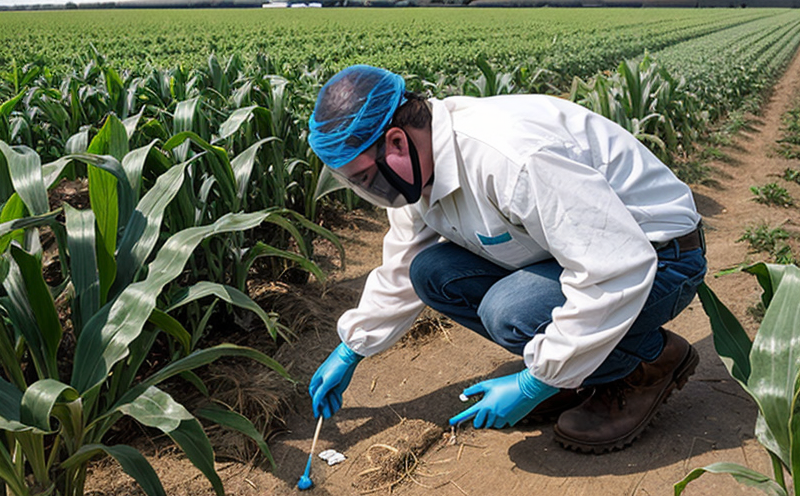Atrazine Residue Testing in Crops
Understanding atrazine residue testing is crucial for ensuring agricultural sustainability and food safety. Atrazine is a widely used herbicide that can persist in the environment, leading to potential residues in crops. This service focuses on accurately detecting and quantifying atrazine levels in various crops, ensuring compliance with international standards.
The process begins with sample collection, which involves selecting representative samples from different parts of the field or storage area. Proper sampling is critical for accurate analysis, as non-representative samples can lead to erroneous results. The collected samples are then transported to our laboratory under controlled conditions to prevent degradation and ensure the integrity of the test.
At our facility, we use state-of-the-art analytical instrumentation such as gas chromatography-mass spectrometry (GC-MS) for precise residue detection. This method allows us to differentiate between atrazine and its metabolites, providing a comprehensive picture of the pesticide's presence in the crop. The analytical process adheres strictly to ISO 17025 standards, ensuring accuracy and reliability.
The acceptance criteria for atrazine residues are defined by regulatory bodies such as the European Union (EU) and the United States Environmental Protection Agency (EPA). Typically, these limits are set at very low levels, often in parts per billion (ppb), to minimize health risks. Compliance with these standards is essential for maintaining market access and consumer confidence.
The importance of atrazine residue testing extends beyond regulatory compliance. It helps farmers optimize their pesticide use, reduces environmental impact, and ensures the safety of agricultural products throughout the supply chain. By detecting residues early in the process, we can provide actionable insights to our clients, enabling them to make informed decisions about crop management.
In summary, atrazine residue testing is a critical component of modern agriculture that balances productivity with sustainability. Our service offers accurate, reliable, and compliant analysis, ensuring that crops meet stringent safety and quality standards.
Scope and Methodology
The scope of our atrazine residue testing covers a wide range of crops including wheat, corn, soybeans, and other major agricultural products. Our methodology is based on standardized procedures that ensure consistent results across different samples and environments.
- Sample Preparation: Samples are initially dried and milled to achieve an appropriate particle size for analysis.
- Extraction: We use a solvent-based extraction process followed by purification steps to isolate atrazine residues from the matrix.
- Detection and Quantification: GC-MS is employed for both qualitative identification and quantitative determination of atrazine and its metabolites.
The entire process is meticulously documented, with detailed records kept for each sample. This comprehensive approach ensures transparency and traceability throughout the testing cycle.
We follow international standards such as ISO 17025 to validate our methods and ensure that our results are accurate and reliable. Our compliance officers work closely with regulatory bodies to stay updated on any changes in guidelines or thresholds, ensuring that our clients remain compliant at all times.
Competitive Advantage and Market Impact
Our atrazine residue testing service stands out due to its precision, reliability, and adherence to international standards. By providing accurate results, we enable our clients to make informed decisions about their pesticide usage, ultimately leading to safer agricultural practices.
The market for atrazine residue testing is growing as global demand for safe and sustainable food products increases. Our service helps farmers and processors stay ahead of regulatory changes and consumer expectations by offering a proactive approach to compliance. This not only enhances brand reputation but also opens up new markets and opportunities.
Our clients benefit from our expertise in interpreting test results, providing actionable insights that can improve crop yields while minimizing environmental impact. By leveraging this knowledge, they can optimize their farming practices and reduce costs associated with non-compliance or recalls.
Use Cases and Application Examples
- Certification Programs: Our testing supports certification programs that require strict atrazine residue limits for export markets. Farmers can use our results to demonstrate compliance, thus enhancing their marketability.
- R&D Projects: Agricultural researchers use our data to study the long-term effects of atrazine on soil health and crop productivity. This information is crucial for developing more sustainable farming practices.
- Supply Chain Management: Processors and distributors rely on our results to ensure that their products meet safety standards, thereby protecting consumer health and maintaining brand integrity.
- Environmental Monitoring: Our data helps environmental agencies monitor atrazine levels in agricultural runoff, providing insights into potential pollution sources.
In conclusion, our atrazine residue testing service plays a vital role in the agriculture sector by ensuring compliance with regulatory standards and supporting sustainable practices. Whether for certification purposes or R&D projects, our clients can trust us to deliver reliable and accurate results.





